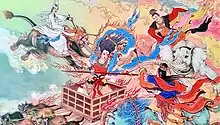.jpg.webp)
Wenshu Guangfa Tianzun (simplified Chinese: 文殊广法天尊; traditional Chinese: 文殊廣法天尊; pinyin: Wénshū Guǎngfǎ Tiānzūn) is a Taoist deity and character in the classic Chinese novel Investiture of the Gods (more commonly known as Fengshen Yanyi). He is a disciple of Yuanshi Tianzun and one of the Three Great Immortals, holding the fifth position among the Twelve Golden Immortals.[1]
The character is believed to be derived from the bodhisattva Manjusri.[2][3] The books Qunxian Xianpo Tianmen and Western Tang Dynasty Biography states Wenshu Guangfa Tianzun and Manjusri Bodhisattva are not the same person.[4][5][6] It is believed that Manjusri Bodhisattva transformed into Wenshu Guangfa Tianzun, one of the protectors in Taoism, helping to resolve religious conflicts common in the Western regions.[7]
Legend
In Fengshen Yanyi, Guangfa Tianzun is the superiorman over Five Dragons Mountain, Cloud Top Cave, and the renowned teacher of Jinzha, the first son of Li Jing. In rank, Guangfa Tianzun is seemingly an elite superiorman—even greater than that of Nezha's teacher, Taiyi Zhenren.[8]
After a fine duel had ensued between Muzha and Nezha and Li Jing attempted his first suicide, Guangfa Tianzun would appear. Once Guangfa Tianzun had ordered Li Jing to enter his cave for safety, he would personally settle things with the "spoiled brat" Nezha. Once Nezha's temper raged and he thrust his spear continuously at Guangfa Tianzun, Guangfa Tianzun would side step and throw his legendary Seven Treasure Golden Lotus over Nezha's head. Nezha would lose consciousness quickly following this and would find himself tied to a large gold post while cuffed by golden rings. Soon enough, Guangfa Tianzun would order Jinzha, his student, to flog Nezha. Following the arrival of Nezha's teacher, Taiyi Zhenren, it would be revealed that the whole event between Li Jing and Nezha had been set by Taiyi Zhenren as a chance to teach Nezha some discipline. After Nezha greeted Guangfa Tianzun and his master, who was sitting to Guangfa Tianzun's right, Nezha would have a great level of inner resentment.[9]

After Nezha and Li Jing departed on the orders of Guangfa Tianzun, he remained absent from sight for quite some time. During the Battle of the Ten Thousand Immortals, along with Puxian Zhenren and Cihang Zhenren, he faced off against the powerful disciple of the Jie Sect, Jinling Shengmu. He once shattered the 'Tianjue Formation', the first formation of the Ten Jue Formations of the Jie Sect, and killed Qinwan Tianjun, eliminating a threat to the Chan Sect. Later, he was captured by Sanxiao Niangniang (Yunxiao Niangniang, Qiongxiao Niangniang and Bixiao Niangniang) using the Chaos-Origin Gold Gourd and imprisoned within the Grand Nine-Curves Yellow River Formation, which drained his magical powers. However, he managed to eventually restore his cultivation.[10]
In the end, among the disciples of the Chan Sect and the Jie Sect, those with the highest level of Dao cultivation ascended to become deities upon entering the Register of Deities, while those with lesser cultivation entered as divine beings or immortals, and those with lower levels of cultivation were reborn in the cycle of reincarnation. Some disciples also joined Western Buddhism, including the Chan Sect's Cihang Zhenren (later known as Guanyin), Wenshu Guangfa Tianzun (later known as Manjushri), and Puxian Zhenren (later known as Samantabhadra).[11]
Temple
Located in the southwestern suburb of Chengdu, Sanqing Hall within Qingyang Palace is a temple dedicated to the supreme Taoist god Sanqing. In the center of the hall sits a statue of Sanqing, and on both sides of the hall are the disciples of Sanqing, including the Twelve Golden Immortals, including Wenshu Guangfa Tianzun. This historical temple traces its origins back to the Tang Dynasty and underwent significant reconstruction during the Kangxi period of the Qing Dynasty. The foundation of Sanqing Hall takes the form of a square, covering a total area of 1,600 square meters.[12]
References
- ↑ 预见学习,遇见成长:学校开展项目学习的实践与探索 (in Chinese (Taiwan)). Beijing Book Co. Inc. 1 April 2020. ISBN 978-7-5068-7821-0.
- ↑ 四川道敎史话 [Sichuan Taoist History] (in Chinese). 四川人民出版社. 1985.
... 文殊广法天尊、慈航道人、燃灯道人、普贤真人等等是借用的佛教菩萨,小说中贯穿着儒、道、释三教合一的思想,从民间信仰的角度,它详尽地解说了众神的由来,所有这些都为神道设教。但是它也只是"迹近"而已,它与《搜神记》之类的志怪小说有本质的不同
- ↑ 中国古代, 近代文学研究 [Ancient Chinese and Modern Literature Research] (in Chinese). 中国人民大学书报资料社. 2004.
- ↑ 当代 (in Chinese). 人民文学出版社. 2009.
... 文殊广法天尊" ,这与三教中的大师法号习惯带"子" ,如"广成子" "云中子" "赤精子"也大异其趣。却不可认为这位"文殊"便真是佛家那位"文殊菩萨" [Translation:... Wenshu Guangfa Tianzun," this differs significantly from the usual naming conventions for masters in the Three Religions, where they typically include "Zi" (子) in their titles, such as "Guangcheng Zi," "Yunzhong Zi," "Chijing Zi," and others. However, it should not be assumed that this "Wenshu" is indeed the same as the Buddhist figure "Manjushri Bodhisattva."]
- ↑ "《封神演义》看似崇道,实则敬佛". China Literature Network (in Chinese). 30 July 2021.
- ↑ 洮石老坑 (in Chinese). Beijing Book Co. Inc. 1 August 2017. ISBN 978-7-5490-1424-8.
... 文殊师利菩萨被称为"文殊广法天尊",普贤菩萨被称为"普贤真人",他们用各自的无量法力,普救人间疾苦,而观音则是大乘佛教慈悲救世精神的最深刻诠释。显然阮煜兴先生创作该砚的初衷,首先应是发现了原料的珍奇,外加对佛法的敬仰,便以端庄慈祥、手持净瓶杨柳 ...
- ↑ 中华文化视域下民族镜像的传播 [The Communication of Ethnic Images in the Context of Chinese Culture] (in Chinese). Beijing Book Co. Inc. 1 May 2017. ISBN 978-7-5643-5446-6.
... 文殊菩萨变成了道教护法之一的文殊广法天尊,化解了西洋常见的宗教争端。不过,值得注意的是这种宗教精神与传统的"慎独"有所区别:前者的反省在于给予万事万物名分,象征性地建立各种意义形象,诸如唐朝为功臣建立的凌烟阁[77],使得忠义之士全都封神,其中不乏 ...
- ↑ 中国神话人物辞典 [Dictionary of Chinese Mythological Characters] (in Chinese). 陝西人民出版社. 1998. p. 55. ISBN 978-7-224-04279-5.
- ↑ 封神演義 (in Chinese). 岳麓書社. 2009. ISBN 978-7-80761-080-9.
- ↑ 三霄传 [The Legend of Sanxiao] (in Chinese). Beijing Book Co. Inc. 1 August 2017. ISBN 978-7-227-06739-9.
- ↑ 中国神仙年画经典 (in Chinese). Beijing Book Co. Inc. 1 September 2015. ISBN 978-7-5507-1452-6.
...阐教门人因三尸未除,犯下杀戒而入世受劫难。阐教、截教中众门人道行最高的成仙,道行次高的入封神榜成神,道行较低的入轮回成人。还有部分门人入西方教,如阐教中慈航道人(后为观世音菩萨)、文殊广法天尊(后为文殊菩萨)、普贤 ...
- ↑ 老成都记忆 (in Chinese). Beijing Book Co. Inc. 1 March 2017. ISBN 978-7-5090-1171-3.
- Investiture of the Gods chapter 14 pages 167 - 169